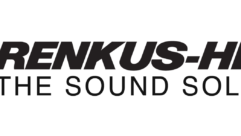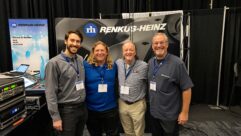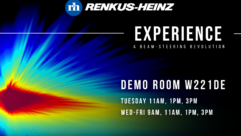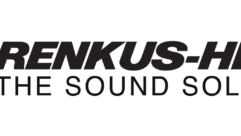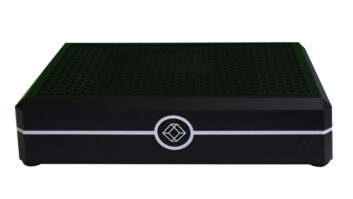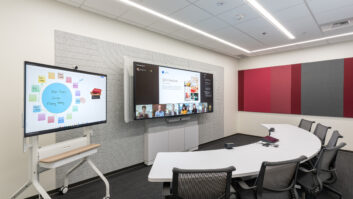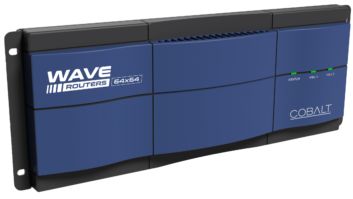Peer Review- Renkus-Heinz Iconyx Column Array
Renkus-Heinz Iconyx loudspeaker technology provides very effective control of acoustic energy, which is essential in difficult acoustic spaces, without sacrificing the sound quality clients expect from any well designed speaker system.
David Bick
Peer Reviewer:David Bick, acoustical/systems engineer, McClure Engineering Inc., St. Louis. McClure Engineering Inc. designs building systems, including sound and video, acoustics, lighting, theatrical rigging, mechanical, electrical, plumbing, fire protection, temperature control, fire alarm, and telecommunications.
My Pick:
Renkus-Heinz Iconyx Digitally Steerable Column Array, $4,875 to $19,470 MSRP, depending on configuration.
What I Like About It:
Renkus-Heinz Iconyx loudspeaker technology provides very effective control of acoustic energy, which is essential in difficult acoustic spaces, without sacrificing the sound quality clients expect from any well designed speaker system. Iconyx column arrays can produce very tight lobes — as small as 5 degrees of vertical dispersion. Each IC8 module can generate up to four of these lobes, which can be steered up or down independently of the array’s mounting angle. This enables us to mount the Iconyx arrays flush to walls or columns while maintaining consistent SPL from the front to the rear of the audience area. In addition, the tight vertical pattern control helps maintain a high ratio of direct to reverberant sound.
MANUFACTURER’S SPECIFICATIONS
D2 DSP/Amplifier
Sensitivity: 1.0 V (for rated power output)
Frequency Range: 120 Hz to 18 kHz
Max. SPL @ 20 Meters: 96 to 103 dB (peak), depending on configuration; 93 to 100 dB (program), depending on configuration
Horizontal Dispersion: 150 degrees, up to 3 kHz; 120 degrees, above 3 kHz
Aiming Angle: Adjustable from -20 degrees to +20 degrees
Typical Throw: 20 to 80 m, depending on configuration
Number of Transducers: Eight to 32, depending on configuration
Number of Amplifier Channels: Eight to 32, depending on configuration
Power Required: 24 to 96 VA (idle), depending on configuration; 325 to 1,300 VA (at rated output), depending on configuration
Weight: 35 to 140 pounds, depending on configuration
Type: Eight-channel, Class D amplifier/DSP processor
Power Rating: 50 W RMS per channel; 150 W burst
Frequency Range: +3, -3 dB, 20 Hz to 20 kHz
THD Distortion: Less than 0.05 percent typical
Hum and Noise: Less than 100 dB (A weighted)
Inputs: 10K ohm balanced differential (standard); CobraNet or AES/EBU (optional)
Input Sensitivity: 1.0 V for rated power output
Common Mode Rejection: 74 dB
Gain: DSP controlled, 0 to -60 dB in 1 dB steps
EQ: Five-band parametric
Power: Universal 90/260 VAC, 50/60 Hz 2.4 A @ 120 V, 1.2 A @ 240 V
Iconyx arrays are also pleasant to listen to, especially with additional low-frequency (subwoofer) support. Some other column arrays I’ve heard are intelligible for speech, but make you wonder why someone even bothered to put music through them.
As a designer, I’m quite pleased with the development of the Iconyx software package, BeamWare, which makes the task of adjusting an Iconyx array’s coverage to a section view of the audience relatively quick and painless. It can export a configuration file to EASE or EASE JR for 3D predictions of the acoustical results.
I Would Change:
I would prefer it if Canvas, a separate application used to tune and commission an Iconyx system by adjusting levels and EQ, were integrated into either the BeamWare software or perhaps made available as a module for EASERA. That would make it easier to measure the results of EQ and level adjustments in real time.
Where I Used It:
I installed the Renkus-Heinz Iconyx array in a recent project at Salem Lutheran Church in St. Louis, where the client’s primary goal was high speech intelligibility for the spoken word throughout the entire seating area of the sanctuary.
My Results:
The results were outstanding. Now, the entire congregation can hear the pastor very clearly throughout the space, and with an accompanying subwoofer, the church is now capable of reinforcing a full-bandwidth choir.
The small size of the Iconyx loudspeaker cabinet made it easy to get aesthetic approval, as it discreetly blends in with the platform side walls. There’s a learning curve associated with any new technology. BeamWare has some fairly intuitive tools for optimizing a single Iconyx array, but for multi-array installations, you’ll want to use EASE JR or EASE as well. If you’ve never worked with this kind of system before, it can be a bit of a shock to discover that merely getting up from a seat can put a listener “out of the pattern.” But once you understand how to use this kind of system, and where it’s most appropriate, it solves problems where all other approaches have failed.
SUBMIT A PEER REVIEW
Always wanted to review a product? Contact the Pro AV staff at [email protected] to become one of our peer reviewers.


